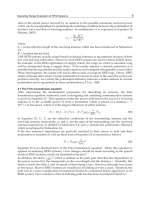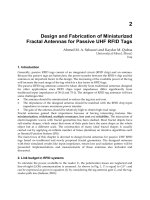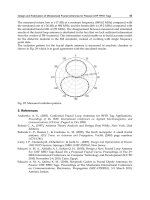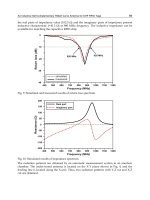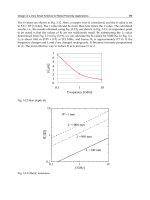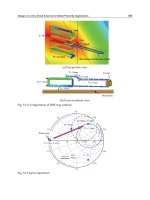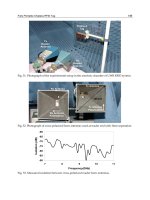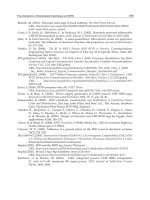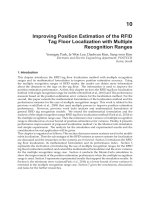Advanced Radio Frequency Identification Design and Applications Part 10 pdf
Bạn đang xem bản rút gọn của tài liệu. Xem và tải ngay bản đầy đủ của tài liệu tại đây (1.63 MB, 20 trang )
Bustillo, M. (2010). Wal-mart radio tags to track clothing, The Wall Street Journal .
URL: />html? mod=WSJ_article_related.
Curty, J P., Joehl, N., Dehollain, C. & Declercq, M. J. (2005). Remotely powered addressable
UHF RFID integrated system, IEEE Journal of Solid-State Circuits 40(11): 2193–2202.
Diaz, A. & Felix-Navarro, R. (2004). A semi-quantitative tribo-electric series for polymeric
materials: the influence of chemical structure and properties, Journal of Electrostatics
62: 277–290.
Dobkin, D. M. (2008). The RF in RFID: Passive UHF RFID in Practice, Communications
Engineering Series, Newnes, an imprint of Elsevier, 30 Corporate Drive, Suite 400,
Burlington, MA 01803.
EPCglobalGen1 (2002). 860 MHz - 930 MHz Class 1 Radio Frequency Identification Tag Radio
Frequency and Logical Communication Interface Specification Candidate Recommendation,
Version 1.0.1, 1.0.1 edn, EPCglobal.
URL: />_ Tag_ Radio_Frequency_Logical_Communication_Interface_Specification.pdf.
EPCglobalGen2 (2008). EPC™Radio-Frequency Identity Protocols Class-1 Generation-2 UHF
RFID Protocol for Communications at 860 MHz - 960 MHz, Version 1.2.0, EPCglobal.
URL: />080511.pdf.
Evers, J. (2006). RFID passports take off, CNET News .
URL: />Facen, A. & Boni, A. (2006). Power supply generation in CMOS passive UHF RFID tags,
Research in Microelectronics and Electronics 2006, Ph. D., pp. 33–36.
Finkenzeller, K. (2003). RFID Handbook: Fundamentals and Applications in Contactless Smart
Cards and Identification, 2nd edn, John Wiley and Sons Ltd., The Atrium, Southern
Gate, Chichester, West Sussex PO19 8SQ, England.
Glidden, R., Bockorick, C., Cooper, S., Diorio, C., Dressler, D., Gutnik, V., Hagen, C., Hara,
D., Hass, T., Humes, T., Hyde, J., Oliver, R., Onen, O., Pesavento, A., Sundstrom,
K. & Thomas, M. (2004). Design of ultra-low-cost UHF RFID tags for supply chain
applications, 42(8): 140–151.
Glover, B. & Bhatt, H. (2006). RFID Essentials, O’Reilly Media Inc., 1005 Gravenstein Highway
North, Sebastopol, CA 95472.
Greason, W. D. (1989). Influence of a ground plane on the ESD event in electronic systems,
25(2): 224–229.
IEC61000-4-2 (2005). International Standard 61000-4-2, Electromagnetic Compatibility (EMC)-Part
4-2: Testing and Measurement Techniques - Electrostatic Discharge Immunity Test, 1.1 edn,
International Electrotechnical Commission.
Impinj (2005). ESD and the RFID tag, Impinj Whitepaper .
URL: />Impinj (2010). Monza 3 tag chip datasheet, Impinj Datasheet .
URL: />Karthaus, U. & Fischer, M. (2003). Fully integrated passive UHF RFID transponder
IC with 16.7-μW minimum RF input power, IEEE Journal of Solid-State Circuits
38(10): 1602–1608.
169
The Interaction of Electrostatic Discharge and RFID
Nikitin, P. V., Rao, K. V. S., Lam, S. F., Pillai, V. andMartinez, R. & Heinrich, H. (2005).
Power reflection coefficient analysis for complex impedances in RFIDtag design,
IEEE Transactions on Microwave Theory and Techniques 53(9): 2721–2725.
Ott, H. W. (1988). Noise Reduction Techniques in Electronic Systems, 2nd edn, John Wiley and
Sons Inc.
Shaw, M. (2004). Pushing past paper, Pulp and Paper .
Sood, B., Das, D., Azarian, M., Pecht, M., Bolton, B. & Lin, T. (2008). Failure site isolation on
passive RFID tags, 15th International Symposium on the Physical and Failure Analysis of
Integrated Circuits, 2008, IPFA 2008, pp. 1–5.
StaticSolutions (n.d.). Ohm-stat™FM-1125 digital ESD field meter, FM-1125 Datasheet .
URL: />Torrance, R. (2009). RFID s power themselves, EDN May 4.
URL: www.edn.com/article/458664-RFIDs_power_themselves.php.
170
Advanced Radio Frequency Identification Design and Applications
Part 2
Advanced RFID Applications
0
Privacy-enhanced RFID Tag Search System
Ji Young Chun
1
, Jung Yeon Hwang
2
and Dong Hoon Lee
3
1
Graduate School of Information Management and Security,Korea University
2
Electronics and Telecommunications Research Institute (ETRI)
Republic of Korea
1. Introduction
Radio frequency identification (RFID) technology is used to identify RFID-tagged objects
automatically. An RFID system generally consists of three components: an RFID tag, an RFID
reader, and a backend system. An RFID tag is a small device for identification, which is
attached to or embedded in an object. It has an unique identifier and may optionally hold
additional product information for the object. An RFID reader is a device used to interrogate
RFID tags. It can be fixed or portable. It passes c ommunication messages between an RFID
tag and a backend system. A backend system stores and manages the o nline data which are
associates with RFID tags. Since the communication between an RFID tag and an RFID reader
occurs without optical line of sight, RFID tags can be read much longer and much faster than
other automatic identification and data capture ( AIDC) technologies such as Bar-codes and
smartcards. Thanks to these advantages, RFID technology has various applications.
Fig. 1. RFID Tag Search System
Recently, RFID technology has been applied to many real-life applications such as asset
management, supply chain, and product maintenance, etc. Especially, RFID tag search system
9
which can be used to find RFID-tagged objects is one of the promising applications of RFID
technology. For example, this system can be used to search for missing children and find books
in a library (See Fig. 1). This system also can be used to find and monitor an offender who
has an electronic tag. Consider the situation which can easily happen in the library. Everyday
librarians arrange books in order in its place. However, since they may be handled by many
people, books are constantly misplaced on the shelves. When someone wants to borrow a
book which is not checked out, if the book is not where it should be one must scan the entire
shelves to find the misplaced book. Fortunately if the book is nearby, the search is quickly
ended. Otherwise, one should do an exhaustive search. This is too time-consuming. If RFID
tag search system is used in the library, one can e fficiently find the misplaced book among
extensive RFID-tagged books.
Although RFID technology provides various benefits because of its convenience, there is
growing concern about RFID security and privacy. When someone holds RFID-tagged objects,
attackers can discover his personal information which is stored in RFID tags and can track
his movement using IDs of RFID tags. Besides these attacks, there are many security and
privacy threats. Therefore, when we implement RFID technology, we should consider security
and privacy threats. There are numerous researches focusing on RFID security and privacy
issues (Burmester et al., 2008; Gilbert et al., 2008; Juels & Weis, 2005; Ohkubo et al., 2003;
Paise & Vaudenay, 2008; Rotter, 2008; Rieback et al., 2006; Tsudik, 2006; Vaudenay, 2007).
Recently, secure protocols for R FID tag search system are proposed for the first time (Tan et
al., 2007; 2008). After that, various RFID tag search protocols have been proposed (Ahamed
et al., 2008;a; Hoque et al., 2009; Won et al., 2008; Zuo, 2009). Even though these protocols
are designed to enhance the security and privacy of RFID tag search system with its own
requirements, there still exist vulnerabilities. Therefore, we first analyze the vulnerabilities of
the previous works and then discuss the corresponding countermeasures.
The remainder of this chapter is organized as follows. We introduce RFID tag search system
in Section 2 and classify some protocols which have been proposed in this area in Section 3. In
Section 4, we point out the vulnerabilities of the previous works, and then analyze the security
and privacy requirements of the RFID tag search system in Section 5. Finally, we conclude the
chapter with future works in Section 6.
2. RFID Tag search system
In this section, we describe the RFID tag search system and the threat model in RFID systems.
Before describing the threat model, we describe system configurations and the basic RFID tag
search p r otocol to clarify the roles of t hree components in RFID tag search system. We then
describe the threat model in RFID systems.
2.1 System configurations
RFID tag search system also consists of three components: an RFID tag, an RFID reader, and
a backend system.
-RFIDTag: RFID tags are categorized into two groups, active and passive, according to
whether they have their own battery or not. Wh ile an active tag has its own battery, a passive
tag does not have an internal battery and passively obtain the operating power from an RFID
reader. In RFID tag search system, it is reasonable that tags are assumed to be passive. Since
tags are usually attached to cheap objects like books or goods, passive tags are more suitable
174
Advanced Radio Frequency Identification Design and Applications
than rather expensive active tags in RFID tag search system. We assume that tags are passive
in this chapter. It is known that the communication range of passive tags is 3m or less (OECD,
2007).
- RFID Reader: An RFID reader can interrogate RFID tags and transfer communication
messages between an RFID tag and a backend system. It supplies the operating power to
passive tags. To give enough operating power to passive tags, the signal strength of an RFID
reader should be strong. Therefore, the communication range of an RFID reader is much
stronger than that of a passive tag, it is about 100m (OECD, 2007). There are two kinds of
RFID readers, fixed and portable. Fixed reader is installed where data capture is required
and it sends and receives RFID tag data to a backend system through the wired networks
(See Fig. 2) . Portable reader which can be mounted in a mobile phone or personal digital
assistant (PDA) uses the wireless networks to communicate wi th a backend system (See Fig.
3). Therefore, fixed reader can be assumed that it has a persistent connection with a backend
system while a persistent connection between portable reader and a backend system cannot
be guaranteed due to unstable wireless connection or distance limitation, etc.
- Backend System: A backend system stores and manages online data of RFID tags. It is
assumed to be trusted and do not compromised.
%DFNHQG6\VWHP
)L[HG5HDGHU 7DJV
:LUHG
1HWZRUNV
Fig. 2. Fixed Reader
%DFNHQG6\VWHP
3RUWDEOH5HDGHU 7DJV
:LUHOHVV
1HWZRUNV
Fig. 3. Portable Reader
2.2 Basic RFID tag search protocol
RFID tag search is to find a particular RFID tag using an RFID reader. In more detail, an RFID
reader can determine whether a particular tag exists nearby the RFID reader using RFID tag
175
Privacy-enhanced RFID Tag Search System
search system. Next we present a simple protocol to realize ’RFID tag search’. This basic RFID
tag search system operates as follows:
(1) B ← R : Search request about a particular tag
(2) B
→ R : A tag identifier ID
j
(3) R → T
∗
: ID
j
(4) T
∗
:CheckID
∗
= ID
j
(5) R ← T
j
:Reply
Fig. 4. Basic RFID Tag Search Protocol
(1) When the reader R wants to find a particular tag, it sends a request message about a
particular tag to the backend system B.
(2) The backend system B sends a tag identifier
ID
j
which the reader wants to find to the reader
R.
(3) After receiving
ID
j
,thereaderR broadcasts ID
j
to find the tag.
(4) One of arbitrary tags T
∗
nearby the reader R replays when its own identifier is equal to the
broadcasted identifier
ID
j
.
(5) If the reader receives the reply from the tag T
j
,thereaderR can know the existence of the
tag T
j
.
Despite the simplified structure for a tag search the above basic protocol does not have any
considerations for RFID s ecurity and privacy p roblems. There exist various threats through
malicious attacks in RFID systems. We should consider RFID security and privacy problems
to use RFID tag search system in real-life.
2.3 Threat model
In this subsection, we describe various security and privacy threats in RFID systems and
analyze the basic RFID tag search protocol in terms of these threats. An adversary can mount
the following attacks.
- Eavesdropping Attack: An adversary can eavesdrop all the communication messages between
an RFID reader and RFID tags. When a portable reader is used, an adversary can also
eavesdrop all the communication messages between a portable reader and a backend system.
- Intercept Attack: An adversary can intercept the messages in transmission between RFID
readers and RFID tags. If a message from a reader is intercepted, a tag cannot get this
intercepted message.
- Replay Attack: An adversary can replay the messages which were previously eavesdropped
or intercepted.
- Tampering Attack: An adversary can modify, add, and delete data stored in RFID tags.
- Physical Attack: An adversary can compromise RFID tags. Once tags are compromised
physically, an adversary can know all the secret information stored in RFID tags. An adversary
176
Advanced Radio Frequency Identification Design and Applications
can also do a physical attack to portable readers, since p ortable readers can be easily lost or
stolen. However, a backend system and fixed readers are not compromised.
Using these attacks, an adversary threatens security and privacy in RFID systems as follows.
- Impersonation: An adversary can impersonate a legitimate tag or a legitimate reader. After
an adversary intercepts valid messages from a legitimate tag/reader, she replays these
intercepted messages to a legitimate reader/tag.
- Information Leakage: An adversary can identify a specific tag using eavesdropping attacks.
This attack can breach the privacy of a tag holder.
-Tracking: An adversary can track the movements of an RFID-tagged object such as a tag or a
portable reader using eavesdropping attacks.
- Cloning: An adversary can clone a specific tag using physical and tempering attacks. To make
a clone tag, an adversary physically accesses the secret information of a tag, and then creates
a fake tag which stores this secret information. Using this attack, the adversary can change an
expensive product into a cheap one.
- Denial of Service (DoS): An adversary sends a large amount of requests to a backend system
to disable the RFID tag search system. U nder this attack, a backend system cannot respond to
the request of readers.
- Desynchronization: An a dversary can make a tag and a backend system/reader be
desynchronized by intercepting communication messages. Once a desynchronization
happens, a tag and a backend system/reader cannot communicate with each other any more.
In the basic RFID tag search protocol in Fig. 4 an adversary can eavesdrop all communication
messages between R and T
∗
. An adversary can impersonate a legitimate tag T
j
after
eavesdropping the communication m essages in step (3) and (5). An adversary can also
impersonate a legitimate reader R just by replying identifier,
ID
j
.Thebasicprotocolleaks
the information of tags like
IDs. T h is leads the privacy breaches of a tag holder. An adversary
can k now the sensitive information of a tag holder, such as what a tag ho lder has and what
a tag holder wears. More serious problem of the basic protocol is location tracking. If an
adversary constantly observes the replies of a particular tag, she can track the movements of
this tag and also the movements of a tag holder. A nother security problem is tag cloning since
low-cost passive tags cannot be protected with a temper-proof mechanism. The basic protocol
is vulnerable to DoS attacks. If a backend system is disabled because of DoS attacks, then R
cannot get any tag identifier in step (1) and (2), and so the RFID tag search system cannot be
available.
These threats are general threats i n RFID systems. However, there may exist other threats to
be considered especially in the R FID tag search system. For instance, in the RFID tag search
system, it could be important information to an adversary whether an RFID reader finds a
specific tag or not. This threat is restricted to the RFID tag search system. Therefore, to design
secure protocols in the RFID tag search system, we need to identify threats which are restricted
to the search system. We will analyze previous RFID tag search protocols in the next section
and then identify threats in the RFID tag search system.
177
Privacy-enhanced RFID Tag Search System
3. Classification of previous RFID tag search protocols
In this section, we classify previous RFID tag search protocols (Ahamed et al., 2008;a; Hoque
et al., 2009; Tan et al., 2007; 2008; Won et al., 2008; Zuo, 2009) which are designed to overcome
various threats in the previous section.
3.1 Criteria for classification
We classify previous RFID tag search protocols according to the following criteria which reflect
fundamental design considerations.
1)
Movement of Readers: What kinds of RFID readers are used? Fixed or Portable?
2)
Secret Update: Does each tag update its own secret value after every session?
3)
Response of Tags: Do all tags respond to the request of an RFID reader? or Does the specific
tag respond to the request of an RFID reader while the others keep silent?
4)
Reveal Reader ID: D oes an RFID reader reveal its identifier without any manipulation?
We will describe each criterion in more detail.
3.1.1 Movement of readers
As we described in Section 2, fixed readers use wired networks while portable readers use
wireless networks. Since portable readers are hardly assumed that they have a persistent
connection with a backend system, the search protocol with portable readers should consider
this situation when portable r eaders cannot connect to a backend system. Another p roblem
is that portable readers are easily lost or stolen. Once the readers are compromised, all the
secret information in readers are revealed. Therefore, the search protocol with portable readers
should also consider this situation.
3.1.2 Secret update
When each tag updates its own secret value after every session, a backend system should
update the secret value of this tag at the s ame time. In this case, synchronization be tween a
tag and a backend system is i mportant. If a tag and a backend system are desynchronized,
then this tag cannot be searched any more. Secret update is necessary to be secure against a
physical attack. If an adversary is assumed to be able to mount a physical attack, an adversary
can get the secret information of a tag. After that, an adversary can trace the communication
messages of the tag in previous sessions using the current secret value of a tag if each tag does
not update its own secret value after every session in the search protocol. This means that the
protocol does not provide forward secrecy.
3.1.3 Response of tags
In the RFID tag search protocol, if the specific tag which an RFID reader wants to find responds
to the request of an RFID reader, an adversary can learn whether the reader finds the specific
tag or not. However, if all the tags including the specific tag respond to the request of an RFID
reader, an adversary cannot decide whether the reader finds the specific tag or not. Therefore,
by adjusting the number of responses of tags, we can protect the privacy of an R FID reader
holder. Beside this problem an adversary can trace a tag. If only a specific tag always responds
to a particular message, by sending this particular message repeatedly to the tag, an adversary
178
Advanced Radio Frequency Identification Design and Applications
can trace this tag. However, if all tags respond to a particular message, an adversary cannot
trace the tag.
3.1.4 Reveal reader ID
This criterion is about whether an RFID reader reveals its own ID or not. This is only for the
protocols using portable readers. Since fixed readers passively relay communication messages
between tags and a backend system, tags do not have to know IDs of fixed readers. However,
since portable readers should handle the situation that portable readers cannot connect to a
backend system, they should store secret information of tags. Therefore, tags have to know
IDs of portable readers to communicate with them. To let tags know an ID of a portable reader,
a portable reader sends its own ID to tags. In some circumstance, a revealment of reader’s ID
is not desirable. If an RFID reader sends its own ID without any manipulation, an adversary
can identify this reader and also trace the movement of the reader holder.
F3
5HVSRQVHRI7DJV6HFUHW8SGDWH\
F1
5HVSRQVHRI7DJV6HFUHW8SGDWHQ)L[HG5HDGHU
5HVSRQVHRI7DJVDOO
F2
5HVSRQVHRI7DJVDOO
F4
Fig. 5. Classification of Previous RFID Tag Search Protocols with Fixed Readers
P1
P8
P2
P5
P7
P3
P4
P6
5HVSRQVHRI7DJVDOO
5HVSRQVHRI7DJV
5HVSRQVHRI7DJV
5HVSRQVHRI7DJVDOO
5HYHDO5HDGHU,'\
5HYHDO5HDGHU,'Q
5HYHDO5HDGHU,'\
5HYHDO5HDGHU,'Q
5HYHDO5HDGHU,'Q
5HYHDO5HDGHU,'\
5HYHDO5HDGHU,'\
5HYHDO5HDGHU,'Q
6HFUHW8SGDWH\
6HFUHW8SGDWHQ3RUWDEOH5HDGHU
Fig. 6. Classification of Previous RFID Tag Search Protocols with Portable Readers
179
Privacy-enhanced RFID Tag Search System
Fixed Reader Portable Reader
Secret Update: n Secret Update: y
Secret Update: n
Secret Update: y3): 1 3): all
4): y 4): n 4): y
F1 F3 P1 P2 P3 P8
Table1.6kindsofpreviousprotocols
3.2 Classification
The classification of RFID tag search protocols based on criteria is shown in Fig. 5 and 6. In
Fig. 5 and 6, "Secret Update: y/n" means that each tag updates/does not update its own secret
value after every session in RFID tag search pr otocol. When all tags r espond to the re quest
of an RFID reader, this is denoted by "Response of Tags: all". If the specific tag responds to
the request of an RFID reader, this is denoted by "Response of Tags: 1". "Reveal Reader ID:
y/n" means that the reader ID is revealed/is not revealed from the communication messages
in RFID tag search protocol. This means that an RFID reader sends its own ID to tags without
any manipulation. Based on these criteria, search protocols are divided into 12 categories.
Protocols using fixed readers have 4 categories from
F1toF4 and protocols using portable
readers have 8 categories from
P1toP8.
There are 6 kinds of previous protocols in (Ahamed et al., 2008;a; Hoque et al., 2009; Tan et al.,
2007; 2008; Won et al., 2008; Zuo, 2009) (See Table 1). We select one protocol from each type as
follows.
-Protocol1 in category F1: Protocol one in (Zuo, 2009)
-Protocol2 in category F3: Protocol three in (Zuo, 2009)
-Protocol3 in category P1: First protocol in (Tan et al., 2008)
-Protocol4 in category P2: Fourth protocol in (Won et al., 2008)
-Protocol5 in category P3: RFID search protocol in (Tan et al., 2008)
-Protocol6 in category P8: Enhanced search protocol in (Hoque et al., 2009)
In Table 1 , 3) means the third criterion,
Response of Tags and 4) means the fourth criterion,
Reveal Reader ID.
4. Analysis of previous RFID tag search protocols
In this section, we analyze previously selected RFID tag search protocols. We do not present
the protocols in detail but describe main features and drawbacks.
4.1 Protocol 1 in F
1
In (Zuo, 2009), there is no mention about the movement of readers. However in the Protocol 1
disconnection of an RFID reader is not considered. This is why we classify Protocol 1 as
F1. Since tags do not update their secret information, Protocol 1 does not provide forward
secrecy. That is, an adversary can trace the movement of a tag T
i
in the previous sessions
using compromised secret information k
i
and id
i
of a tag T
i
. The s ecret information can be
obtained through physical attacks. If an adversary stored all communication messages in the
180
Advanced Radio Frequency Identification Design and Applications
Reader R Tag T
∗
calculate F
k
i
( id
i
⊕ H(n
1
))
send θ = F
k
i
( id
i
⊕ H(n
1
))n
1
θ
−−−−−→
calculate F
k
∗
( id
∗
⊕ H(n
1
))
test if F
k
∗
( id
∗
⊕ H(n
1
)) = F
k
i
( id
i
⊕ H(n
1
))
if so, calculate H(id
i
F
k
i
( n
1
))
verify H(id
i
F
k
i
( n
1
))
λ
←−−−−−
send λ = H(id
i
F
k
i
( n
1
))
Fig. 7. Protocol 1
previous sessions, she can check whether a previous communication message (θ, λ)isfroma
tag T
i
or not. After she gets n
1
from θ, she can check whether λ = H(id
i
F
k
i
(n
1
)).
Besides the tr acing problem through physical attacks, there is another tracing problem
through replay attacks in the protocol. If an adversary repeatedly sends the same request
θ, a tag T
i
always sends same response λ. Therefore an adversary can trace a specific tag. If
all tags except a tag T
i
respond to the request of a reader with random values, then Protocol 1
becomes secure against replay attacks. This modified protocol can be classified as F2.
4.2 Protocol 2 in F
3
Reader R Tag T
∗
calculate F
k
i
( id
i
⊕ H(n
1
))F
k
N
i
( id
i
⊕ H(n
1
))
send θ = F
k
i
( id
i
⊕ H(n
1
))
F
k
N
i
( id
i
⊕ H(n
1
))n
1
θ
−−−−−→
calculate F
k
∗
( id
∗
⊕ H(n
1
))
test if F
k
∗
( id
∗
⊕ H(n
1
)) = F
k
i
( id
i
⊕ H(n
1
))
or F
k
∗
( id
∗
⊕ H(n
1
)) = F
k
N
i
( id
i
⊕ H(n
1
))
if either condition is true,
calculate H
( id
i
F
k
i
( n
1
))
verify H(id
i
F
k
i
( n
1
))
λ
←−−−−−
send λ = H(id
i
F
k
i
( n
1
))
if k
i
was used to verify λ update k
i
← H((k
i
L)n
1
)
update k
i
← H((k
i
L)n
1
)
if k
N
i
was used to verify λ
update k
i
← H((k
N
i
L)n
1
)
Fig. 8. Protocol 2
Protocol 2
is similar to Protocol 1, but each tag updates its own secret key after every session.
Therefore this protocol satisfies forward secrecy. Since each tag’s secret key is updated using
a hash function like SHA-1, an adversary cannot know the previous secret key because of the
one-wayness of a hash function. However, the protocol should consider the synchronization
between a reader and a tag. If an adversary mounts an intercept attack to the communication
message λ, a tag T
i
and a reader are desynchronized. To be secure against intercept attacks,
k
N
i
is us ed for the situation when T
i
updated the s ecret key but a reader did not update the
181
Privacy-enhanced RFID Tag Search System
secret value. Therefore a reader should store two secret keys of a tag T
i
, current key and next
should-be key.
We can simply modify
Protocol 2 to be secure against replay attacks u sing the same response
technique in the
Protocol 1. Then the modified protocol can be classified as F
4
.
4.3 Protocol 3 in P
1
Reader R
j
Tag T
∗
calculate h( f (r
j
, t
i
) n
r
) ⊕id
i
send θ = h( f (r
j
, t
i
) n
r
) ⊕ id
i
n
r
r
j
θ
−−−−−→
calculate h( f(r
j
, t
∗
) ||n
r
)
if id
∗
= h( f(r
j
, t
∗
) ||n
r
) ⊕ h( f (r
j
, t
i
) ||n
r
) ⊕ id
i
calculate h( f (r
j
, t
i
) ||n
t
||n
r
) ⊕id
i
verify h( f (r
j
, t
i
) ||n
t
||n
r
) ⊕id
i
λ
←−−−−−
send λ = h( f (r
j
, t
i
) ||n
t
||n
r
) ⊕id
i
n
t
Fig. 9. Protocol 3
This protocol provides serverless RFID search which does not require a persistent connection
to a backend system. A holder of a portable reader may go to a remote location where
a portable reader cannot connect to a backend system to find an RFID-tagged object. To
overcome this p roblem, if portable readers download all the secret information of tags, the n
portable readers can always find particular tags even if they cannot connect a backend server.
However, this approach is not secure against physical attacks. Since portable readers are easily
lost or stolen, an adversary can know all the secret information of tags. Therefore, in
Protocol 3,
a portable reader R
j
stores the information f (r
j
, t
i
)id
i
of each tag T
i
where r
j
and id
i
are IDs
of a portable reader R
j
and a tag T
i
, respectively, and t
i
is a secret key of a tag T
i
.Evenifan
adversary gets the information f
(r
j
, t
i
)id
i
of each tag T
i
from compromised portable reader
R
j
, she cannot get a secret key t
i
of a tag T
i
due to the one-wayness of the function f (·, ·).
This protocol is vulnerable to replay attacks. By sending an eavesdropped message θ
repeatedly, an adversary can trace a specific tag. The responses λ of a specific tag vary in
every session, but a specific tag always sends a response to the same request.
In
Protocol 3, a portable reader R
j
sends its own identifier r
j
. This breaches the privacy of the
reader holder. An adversary can trace the movement of a reader holder just eavesdropping
an ID of a portable reader. Since the signal strength of a reader is much stronger than that of
a tag, an adversary can eavesdrop a message from a reader more easily. Therefore, revealing
IDs of readers may be more serious than revealing IDs of tags in RFID tag search system, since
tags are usually attacked to goods while portable readers are handled by people in RFID tag
search system.
4.4 Protocol 4 in P
2
This protocol does not reveal IDs of readers, hence this protocol protects the privacy of a
reader holder. To let tags know an ID of a reader, the authors use a symmetric encryption
(Feldhofer & Wolkerstorfer, 2007). By decrypting a received message with its own identifier, a
tag can know an ID of a reader. This protocol is also secure against replay attacks. Since each
tag stores ltime which is the last time to communicate with a reader, tags can check whether a
received message is replayed or not using this value. If ctime from a received message is less
than ltime, tags do not respond to the request of a reader.
182
Advanced Radio Frequency Identification Design and Applications
Reader R
j
Tag T
∗
generate ctime
calculate S
1
= E
id
i
( ctim e ⊕r
j
)
calculate S
2
= E
ctime⊕r
j
(E
t
i
(r
j
⊕id
i
))
send θ = ctimeS
1
S
2
θ
−−−−−→
if ctime > ltime then
calculate D
ownid
( S
1
) ⊕ ctime = r
j
calculate D
ownt
(D
ctime⊕r
j
( S
2
)) ⊕ r
j
= id
i
if id
i
= ownid then
generate n
t
calculate S
3
= E
ownid⊕n
t
( S
1
)
verify S
1
= D
id
j
⊕n
t
( S
3
)
λ
←−−−−−
send λ = S
3
n
t
ltime ← ctime
Fig. 10. Protocol 4
While ctim e is useful to defeat replay attacks, it can be used for malicious attacks. After
stealing a portable reader, an adversary sends a request message θ with ctime
which is much
bigger than current time. A tag T
i
accepts this message since cti me
is much bigger than ltime.
And then updates ltime with ctime
. After that, a tag T
i
cannot communicate with honest
portable readers until ctime
.
4.5 Protocol 5 in P
3
Reader R
j
Tag T
∗
calculate h( f (r
j
, t
i
) n
r
) ⊕id
i
send θ = h( f (r
j
, t
i
) n
r
) ⊕ id
i
n
r
r
j
θ
−−−−−→
calculate h( f(r
j
, t
∗
) ||n
r
)
if id
∗
= h( f(r
j
, t
∗
) ||n
r
) ⊕ h( f (r
j
, t
i
) ||n
r
) ⊕ id
i
calculate λ = h( f (r
j
, t
i
) ||n
t
) ⊕ id
i
λ
←−−−−−
then send λ = h( f(r
j
, t
i
) ||n
t
) ⊕ id
i
n
t
else choose random number rand and n
t
λ
←−−−−−
then send λ = randn
t
verify h( f (r
j
, t
i
) ||n
t
) ⊕id
i
with the predefined probability
Fig. 11. Protocol 5
Protocol 5
improves Protocol 3 in that Protocol 5 is secure against replay attacks. Since all
tags respond to the request of a reader with the predefined probability, an adversary cannot
trace a specific tag using replay attacks. However, alike
Protocol 3, Protocol 5 has the privacy
problem that the protocol reveals the IDs of readers. And
Protocol 3 and Protocol 5 do not
provide forward secrecy for such a reason as mentioned in section 4.1.
183
Privacy-enhanced RFID Tag Search System
Reader R
j
Tag T
∗
calculate P(seed
T
i
)
send n
i
= P(seed
T
i
)
n
i
−−−−−→
calculate a = P(seed
T∗
)
if a = n
i
then
calculate k
= M(seed
T∗
), x = P(k)
and seed
T
i
= M(k)
x
←−−−−−
send x
else choose random number rand
calculate s
= M(seed
T
i
) and m = P(s)
rand
←−−−−−
send rand with probability λ
if m
= x, seed
T
i
= M(s)
Fig. 12. Protocol 6
4.6 Protocol 6 in
P
8
Protocol 6 does not reveal an ID of a reader and provides forward secrecy. And the protocol is
also secure against r eplay attacks s ince all tags respond to the request of a reader. However,
Protocol 6 is not secure against intercept attacks. If an adversary intercepts a communication
message x, a tag T
i
and a reader R
j
are desynchronized. After this session, they cannot
communicate with each other. If
Protocol 6 uses the technique in Protocol 2, Protocol 6 can
become secure against intercept attacks.
Another drawback of the protocol is a storage cost. In the protocol, tags should store seeds
as many as the number of portable readers. This can be a burden to resource constraint tag s.
This protocol is not designed for scalability. To use a new portable reader R
,alltagsshould
store a seed for the reader R
. This may take much time when huge tags are used in this search
system.
5. Security & privacy requirements in RFID tag search system
We previously described threats in RFID systems in Section 2. These threats are s till major
threats in RFID tag search system. However, there may exist other threats to be co nsidered
in RFID tag search system. In this s ection, we analyze security and privacy requirements in
RFID tag search system based on the analysis of previous protocols.
We first simply describe security and privacy requirements which are analyzed based on the
threats in Section 2.
1) Authentication: A backend system and a portable reader must be convinced that tags who
communicate with them are legitimate. If a uthentication is not provided in the protocol, an
adversary can impersonate a legitimate tag using malicious attacks such as intercept attacks
and replay attacks.
2) Confidentiality: An adversary should not be able to extract any information from
eavesdropped messages. If an RFID tag search protocol does not provide confidentiality, the
protocol leaks secret information.
3) Anti-tracking: An adversary should not be able to trace the movements of RFID-tagged
objects.
184
Advanced Radio Frequency Identification Design and Applications
4) Anti-cloning:Anadversaryshouldnotbeabletomakeclonedtags.
5) Anti-DoS attacks: Even if an adversary mounts DoS attacks, an RFID tag search system
should not be disabled.
6) Synchronization: Tags and a backend system/ a reader are always synchronized even if an
adversary tries to break the synchronization.
To find a particular tag, both fixed reader and portable reader can be used. A fixed reader
is installed at location where searches of RFID-tagged objects are required. Therefore a fixed
reader can find a specific tag that is ne arby a fixed reader. For example, to cover all area in
a library, 15 fixed readers are needed (See Fig. 13). However portable reader provides more
flexible searches. To find a particular tag, a user just moves around with a portable reader.
Fig. 13. Fixed reader and Portable reader
When a portable reader is used in RFID tag search system, we should consider the privacy of
an RFID reader holder. The communication range of a tag is 3m, while the communication
range of a reader is 100m (See fig. 14). The area where an adversary can eavesdrop a message
from a tag is 9πm
2
and the area where an adversary can eavesdrop a message from a reader
is 10000πm
2
. Therefore, a m essage from a reader can be eavesdropped much e asier than a
message from a tag. Moreover, since tags usually are attached to goods in RFID tag search
system while readers are handled by people, the privacy breaches of a portable reader can be
more serious than that of a tag.
185
Privacy-enhanced RFID Tag Search System
P
P
Fig. 14. Communication ranges of a tag and a reader
Requirements P 1 P 2 P 3 P 4 P 5 P 6
1) Authentication x
√
x
√√√
2) Confidentiality
√√√√√√
3) Anti-tracking x
√
x
√√√
4) Anti-cloning xxxxxx
5)
Anti-DoS attacks xx
√√√√
6) Synchronization −
√
−−−x
7)
Reader ID privacy −−x
√
x
√
8) Availability −−
√√√√
9) Leakage Resilience −−
√√√√
10) Protect response of tags xxxx
√√
Table 2. Security and Privacy Properties
Besides the security and privacy requirements which are mentioned above, additionally
required requirements in RFID tag search system are as follows.
7) Reader ID privacy: In an RFID tag search protocol, an ID of a reader should not be revealed.
If a portable reader sends its own ID in every session, an adversary can identify the reader
and trace a portable reader holder using this static value.
8) Availability: Even i f a portable reader cannot connect to a backend system, an RFID reader
should be able to find a particular tag which a reader wants to find.
9) Leakage Resilience: Even if a portable reader is compromised, an adversary should not be
able to know secret information of tags.
10) Protect response of tags: If a particular tag responds to the request of a reader, an
adversary can trace this tag using replay attacks. Therefore, an RFID search protocol protects
the response of tags.
The security and privacy properties of selected 6 protocols are summarized in Table 2.
The only one requirement which is not satisfied by selected 6 protocols is anti-cloning. To
design a secure protocol against cloning, physical unclonable functions (PUFs) are proposed
(Tuyls & Batina, 2006). PUFs are used as a secure memory to store a secret key on a tag. It will
186
Advanced Radio Frequency Identification Design and Applications
be an interesting work to design an RFID tag search protocol secure against cloning using the
idea of PUFs.
6. Conclusion
In this chapter, we introduce privacy-enhanced RFID tag search system. After describing
the threat model in RFID systems, we classify previous RFID tag search protocols which are
designed to overcome various threats. And we analyze these protocols and draw security and
privacy requirements in RFID tag search system based on the analysis. Our analysis is helpful
to researchers who want to design secure protocols in RFID tag search system. Our future
work is to improve some protocols which have drawbacks in 6 selected protocols.
7. References
Ahamed, S.I.; Rahman, F.; Hoque, E.; Kawsar, F. & Nakajima, T. (2008). S3PR: Secure Serverless
Search Protocols for RFID, Proceedings of Information Security and Assurance(ISA), pp.
187-192, Apr. 2008.
Ahamed, S.I.; Rahman, F.; Hoque, E.; Kawsar, F. & Nakajima, T. (2008) Secure and Efficient
Tag Searching in RFID Systems using Serverless Search Protocol, International Journal
of Security and Its Application s, Vol. 2, No. 4, pp. 57-66, Oct. 2008.
Burmester, M.; Medeiros, B. & Motta, R. (2008) Provably Secure Grouping-Proofs for RFID
Tags, Proceedings of CARDIS, LNCS 5189, pp. 176-190, Sep. 2008.
Feldhofer, M. & Wolkerstorfer, J. (2007) Strong crypto for RFID tags-A comparison of
low-power hardware implementations, Proceedings of IEEE International Symposium
on Circuits and Systems(ISCAS), pp. 1839-1842, May. 2007.
Gilbert, H.; Robshaw, M. & Seurin, Y. (2008) HB
: Increasing the Security and E fficiency of
HB+, Proceedings of Advances in Cryptology - EUROCRYPT, LNCS 4965, pp. 361-378,
Apr. 2008.
Hoque, Md.E.; Rahman, F.; Ahamed, S.I. & Park, J.H. (2009) Enhancing Privacy and Security
of RFID System with Serverless Authentication and Search Protocols in Pervasive
Environments, Proceedings of Wireless Personal Communications, pp. 1-15, Jul. 2009.
Juels, A. & Weis, S.A. (2005) Authe nticating Pervasive Devices with Human Protocols,
Proceedings of Advances in Cryptology - Crypto, LNCS 3621, pp. 293-308, Aug. 2005.
Ohkubo, M.; Suzuki, K. & Kinoshita, S. (2003) Cryptographic Approach to "Privacy-Friendly"
Tags,RFID Privacy Workshop, Nov. 2003.
Paise, R. & Vaudenay, S. (2008) Mutual authentication in RFID: security and privacy,
Proceedings of ACM Symposium on Information, Computer and Communication s Security
(ASIACCS), pp. 292-299, Mar. 2008.
Rotter, P. (2008) A Framework f or Assessing RFID System Security and Privacy Risks, IEEE
Pervasive Computing, Vol. 7, No. 2, pp. 70-77, Apr. 2008.
Rieback, M.R.; Crispo, B. & Tanenbaum, A.S. (2006) The Evolution of RFID Security, IEEE
Pervasive Computing, Vol. 5, No. 1, pp. 62-69, Jan. 2006.
Tuyls, P. & Batina, L. (2006) RFID-tags for Anti-counterfeiting, Proceedings of CT-RSA,LNCS
3860, pp. 115-131, Feb. 2006.
Tsudik, G. (2006) YA-TRAP: Yet Another Trivial RFID Authentication Protocol, Proceedings of
Pervasive Computing and Communications(PerCom) Workshops, pp. 640-643, Mar. 2006.
187
Privacy-enhanced RFID Tag Search System
Tan, C.; Sheng, B. & Li, Q. (2007) Serverless Search and Authe ntication Protocols for RFID,
Proceedings of Pervasive Computing and Communications(PerCom) Workshops, pp. 3- 12,
Mar. 2007.
Tan, C.; Sheng, B. & Li, Q. (2008) Secure and Serverless RFID Authentication and Search
Protocols, Proceedings of IEEE Transactions on Wireless Communications,vol.7,no.4,
pp. 1400-1407, Apr. 2008.
Vaudenay, S. (2007) On Privacy Models for RFID, Proceedings of Advances in Cryptology -
ASIACRYPT, LNCS 4833, pp. 68-87, Mar. 2007.
Won, T.Y.; Chun, J.Y. & Lee, D.H. (2008) Strong Authentication Protocol for Secure RFID
Tag Search Without Help o f Central Database, Proceedings of IEEE/IFIP International
Conference on Embedded and Ubiquitous Computing, Vol. 2, pp. 153-158, Dec. 2008.
OECD (2007) Radio Frequency Identification (RFID): A Focus o n Information Security
and Privacy, OECD Working Party on Information Security and Privacy,
DSTI/ICCP/REG(2007)9/FINAL, 70 pages, Jan. 2008.
Zuo, Y. (2009) Secure and private search protocols f or RFID systems, Information System
Frontier, Vol. 0, pp. 0-0, August. 2009.
188
Advanced Radio Frequency Identification Design and Applications

